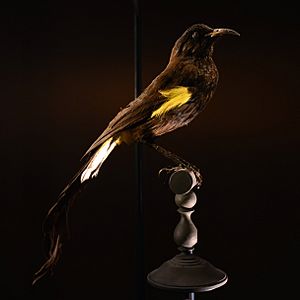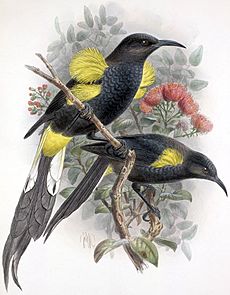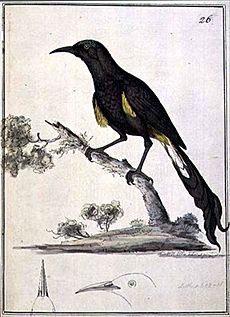Hawaiʻi ʻōʻō facts for kids
Quick facts for kids Hawaiʻi ʻōʻō |
|
|---|---|
 |
|
| Stuffed specimen | |
| Conservation status | |
| Scientific classification | |
| Genus: |
Moho
|
| Species: |
nobilis
|
The Hawaiʻi ʻōʻō (Moho nobilis) was a beautiful bird that lived only on the Big Island of Hawaiʻi. It belonged to a group of birds called the ʻōʻōs, and sadly, all of them are now extinct. This means there are no more Hawaiʻi ʻŌʻōs left in the world. Scientists used to think it was related to honeyeaters, but now they know it was part of its own special family.
Contents
What Did the Hawaiʻi ʻŌʻō Look Like?
The Hawaiʻi ʻŌʻō was first described by a scientist named Blasius Merrem in 1786. It was about 32 centimeters (12.5 inches) long, which is roughly the size of a ruler. Its wings were about 11 to 11.5 centimeters (4.3 to 4.5 inches) long. Its tail could be as long as 19 centimeters (7.5 inches).
This bird had shiny black feathers all over its body, with a brownish color on its belly. One of its most special features was the bright yellow feathers under its wings, near its "armpits." It also had some yellow feathers on its back. However, it did not have yellow feathers on its thighs like the Bishop's ʻŌʻō. It also lacked the whitish edges on its tail feathers that the Oʻahu ʻŌʻō had. The Hawaiʻi ʻŌʻō had the largest yellow feathers on its wings compared to all the other ʻōʻō species.
The name of the volcano cone Puʻu ʻŌʻō is often translated as "Hill of the ʻŌʻō-Bird." This name refers to this very special bird.
Why Did the Hawaiʻi ʻŌʻō Disappear?
When Europeans first arrived in Hawaiʻi, the Hawaiʻi ʻŌʻō was still quite common on the Big Island. However, this soon changed.
How People Used Their Feathers
Native Hawaiians carefully collected the bright feathers of the Hawaiʻi ʻŌʻō. They would only take a few feathers at a time and then release the bird. These striking feathers were used to make special robes (called ʻaʻahu aliʻi), capes (called ʻahu ʻula), and feathered staffs (called kāhili). These items were worn or used by the Hawaiian nobility, known as aliʻi.
Europeans also admired the bird's beauty. Many Hawaiʻi ʻŌʻōs were hunted to be added to personal collections. Some birds were even caught and put into cages to be sold as songbirds. Sadly, these birds often lived only for a few days or weeks. They would get sick from diseases carried by mosquitoes.
The Impact of New Tools
The decline of this bird became much faster when muskets were introduced. Both Native Hawaiians and Europeans used these new guns. Muskets allowed hunters to shoot birds from far away, from great heights, and in large numbers.
As late as 1898, hunters were still able to kill over a thousand of these birds. But after that year, the ʻōʻō population dropped very quickly. The birds became too rare to be shot in large numbers. However, a few were still seen for almost 30 more years. The very last known sighting of a Hawaiʻi ʻŌʻō was in 1934 on the slopes of Mauna Loa.
See also
 In Spanish: Moho nobilis para niños
In Spanish: Moho nobilis para niños




